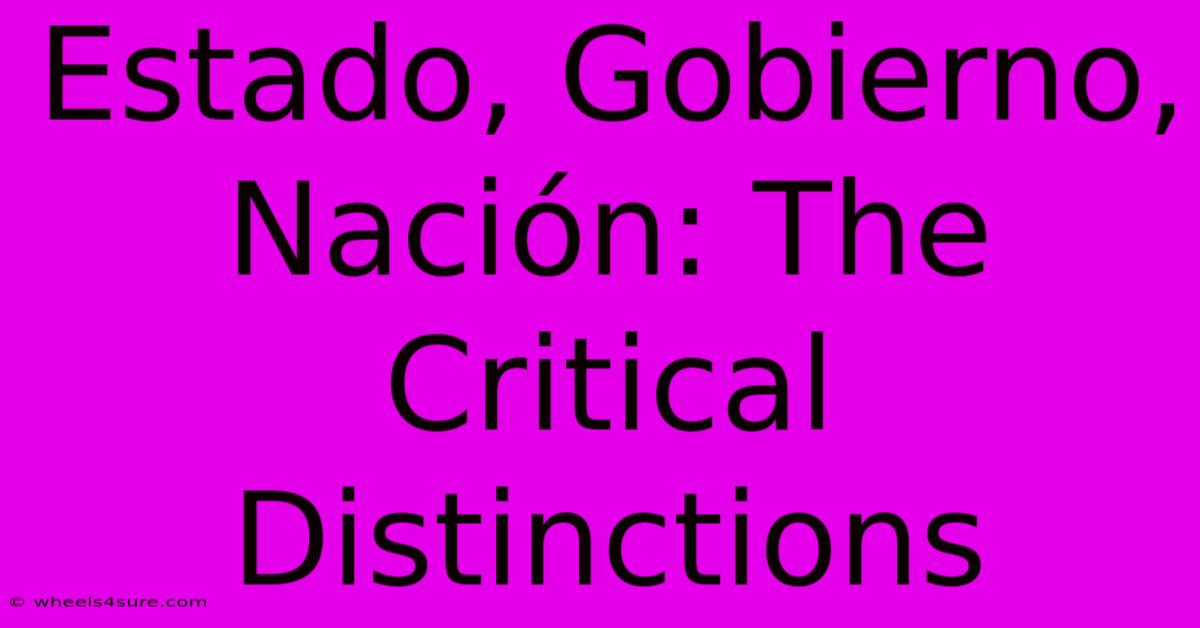Estado, Gobierno, Nación: The Critical Distinctions

Table of Contents
Estado, Gobierno, Nación: The Critical Distinctions
Understanding the nuances between Estado, Gobierno, and Nación is crucial for comprehending political systems and social structures, particularly within the Spanish-speaking world. While often used interchangeably in casual conversation, these terms represent distinct yet interconnected concepts. This article will delve into the critical distinctions between these three key terms, clarifying their meanings and highlighting their interrelationships.
Defining Estado (State)
The Estado, or State, refers to the permanent apparatus of power within a defined territory. It's the overarching entity encompassing the entire system of governance, including its institutions, laws, and sovereignty. This includes:
- Sovereignty: The State possesses supreme authority within its borders, making and enforcing laws without external interference.
- Territory: A clearly defined geographical area under the State's jurisdiction.
- Population: The inhabitants living within the State's territory, subject to its laws.
- Government: The State includes the government, but is not synonymous with it.
Think of the Estado as the entire structure, like a building, complete with its foundation, walls, and roof.
Understanding Gobierno (Government)
The Gobierno, or Government, represents the group of people who exercise political power at a given time. It's the executive branch responsible for implementing the laws and policies of the State. This includes:
- Executive Branch: The President, Prime Minister, or other leading officials and their cabinet.
- Bureaucracy: The administrative staff responsible for implementing government policies.
- Temporary Nature: Unlike the State, the Government is temporary. It changes with elections or other political shifts.
The Gobierno is like the current occupants of the building – they manage it, but the building itself remains.
Exploring Nación (Nation)
The Nación, or Nation, signifies a community of people bound together by shared cultural characteristics, such as language, history, traditions, or ethnicity. Crucially, a nation doesn't necessarily need a defined territory or political structure to exist.
- Cultural Identity: This shared identity is what unites the members of a nation.
- National Identity: A sense of belonging and shared destiny.
- Potential for Statehood: A nation can aspire to form its own State, but it doesn't automatically equate to one.
The Nación is the group of people who could potentially occupy the building (the State), or who feel a connection to the building, even if they don't live in it.
The Interplay Between Estado, Gobierno, and Nación
The relationship between these three concepts is complex and often intertwined. A State usually aims to represent the interests of its Nation, but this isn't always the case. For example:
- Multinational States: Some States encompass multiple nations within their borders.
- Stateless Nations: Some nations don't have their own independent State.
- Nation-States: Ideally, a nation-state would exist where the boundaries of the State align perfectly with the cultural boundaries of the nation. However, this is a rare ideal.
The Gobierno acts as the temporary instrument for the State to represent (or attempt to represent) the nation. It’s a dynamic interaction with many complexities.
Conclusion: Key Differences and Interconnections
While Estado, Gobierno, and Nación are interconnected, their distinct meanings are essential to understand. The Estado is the enduring structure of power, the Gobierno is its temporary leadership, and the Nación is the cultural community it ideally serves. Grasping these distinctions allows for a more nuanced and accurate understanding of political systems and the dynamics of power across the globe. Understanding the relationship between these three components is crucial for comprehending the political landscape and social complexities, particularly in regions with a rich history and diverse cultural identities.

Thank you for visiting our website wich cover about Estado, Gobierno, Nación: The Critical Distinctions. We hope the information provided has been useful to you. Feel free to contact us if you have any questions or need further assistance. See you next time and dont miss to bookmark.
Featured Posts
-
Marioos My Daughter The Song That Will Move You To Tears
Apr 03, 2025
-
The Male Reproductive System From Puberty To Beyond
Apr 03, 2025
-
Evangelos Marinakiss Financial Empire An In Depth Look
Apr 03, 2025
-
Is Mikey Madisons Net Worth Higher Than You Think
Apr 03, 2025
-
Javed Jaffreys Son His Biggest Inspirations
Apr 03, 2025
